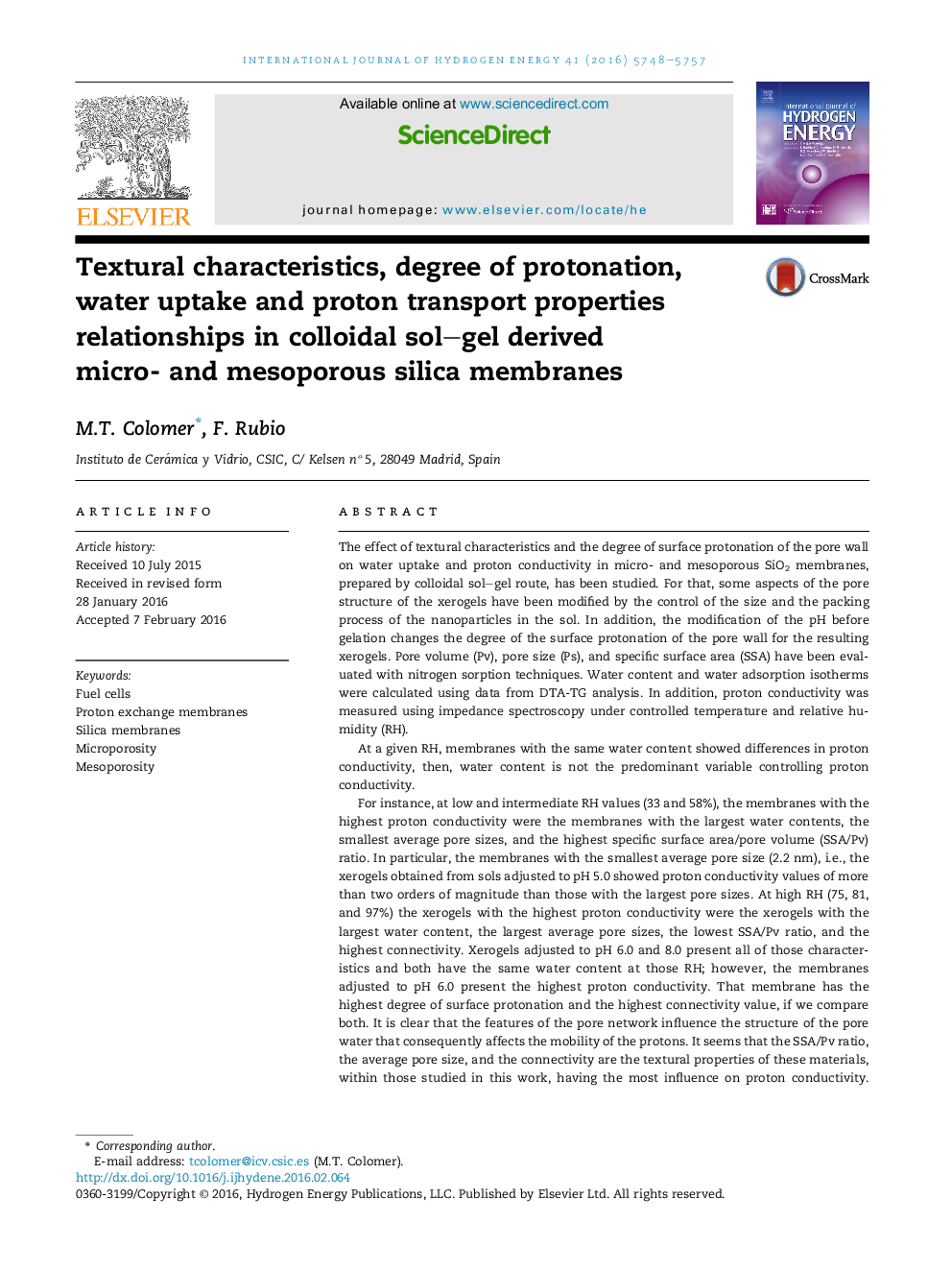| کد مقاله | کد نشریه | سال انتشار | مقاله انگلیسی | نسخه تمام متن |
|---|---|---|---|---|
| 1277688 | 1497412 | 2016 | 10 صفحه PDF | دانلود رایگان |

• Effect of pore structure on water uptake and conductivity in SiO2 was studied.
• The water content is not the prevailing variable controlling proton conductivity.
• Network structure influences pore water structure that affects the proton mobility.
• Surface protonation influences pore water structure that affects the proton mobility.
• Proton conductivity showed an Arrhenius-like dependence on temperature in all cases.
The effect of textural characteristics and the degree of surface protonation of the pore wall on water uptake and proton conductivity in micro- and mesoporous SiO2 membranes, prepared by colloidal sol–gel route, has been studied. For that, some aspects of the pore structure of the xerogels have been modified by the control of the size and the packing process of the nanoparticles in the sol. In addition, the modification of the pH before gelation changes the degree of the surface protonation of the pore wall for the resulting xerogels. Pore volume (Pv), pore size (Ps), and specific surface area (SSA) have been evaluated with nitrogen sorption techniques. Water content and water adsorption isotherms were calculated using data from DTA-TG analysis. In addition, proton conductivity was measured using impedance spectroscopy under controlled temperature and relative humidity (RH).At a given RH, membranes with the same water content showed differences in proton conductivity, then, water content is not the predominant variable controlling proton conductivity.For instance, at low and intermediate RH values (33 and 58%), the membranes with the highest proton conductivity were the membranes with the largest water contents, the smallest average pore sizes, and the highest specific surface area/pore volume (SSA/Pv) ratio. In particular, the membranes with the smallest average pore size (2.2 nm), i.e., the xerogels obtained from sols adjusted to pH 5.0 showed proton conductivity values of more than two orders of magnitude than those with the largest pore sizes. At high RH (75, 81, and 97%) the xerogels with the highest proton conductivity were the xerogels with the largest water content, the largest average pore sizes, the lowest SSA/Pv ratio, and the highest connectivity. Xerogels adjusted to pH 6.0 and 8.0 present all of those characteristics and both have the same water content at those RH; however, the membranes adjusted to pH 6.0 present the highest proton conductivity. That membrane has the highest degree of surface protonation and the highest connectivity value, if we compare both. It is clear that the features of the pore network influence the structure of the pore water that consequently affects the mobility of the protons. It seems that the SSA/Pv ratio, the average pore size, and the connectivity are the textural properties of these materials, within those studied in this work, having the most influence on proton conductivity. Furthermore, the degree of surface protonation of the pore wall seems to have also an important influence on proton conductivity, at least at high RH. The highest value of proton conductivity found was 2.01 × 10−2 Scm−1 at 80 °C and 81% RH and corresponds to the membrane prepared from the sol adjusted to pH 6.0. In addition, proton conductivity showed an Arrhenius-like dependence on temperature in all cases and according to the activation energy values, proton migration is dominated by the Grotthuss mechanism at low and intermediate RH. At high RH the vehicle mechanism also occurs for the xerogels adjusted to pH 6.0 and 8.0 according to the low activation energy values found (0.08–0.13 eV).
The effect of textural characteristics and the degree of surface protonation of the pore wall on water uptake and proton conductivity in micro- and mesoporous SiO2 membranes, prepared by colloidal sol–gel route, has been studied. The figure shows the proton conductivity at 70 °C and the number of water molecules adsorbed per nm2 as a function of RH for the SiO2 membranes prepared. The dependence of the water adsorption uptake and the conductivity have a sigmoidal trend for both micro- and mesoporous materials, and according to the classification of proton conductors as a function of the water vapor partial pressure, the behavior of the silica xerogels is somewhere between an intrinsic (bulk conductor) and a surface conductor.At a given RH, membranes with the same water content showed differences in proton conductivity, then, water content is not the predominant variable controlling proton conductivity. It seems that the SSA/Pv ratio, the average pore size, and the connectivity are the textural properties of these materials, within those studied in this work, having the most influence on proton conductivity. Furthermore, the degree of surface protonation of the pore wall seems to have also an important influence on proton conductivity, at least at high RH.Figure optionsDownload as PowerPoint slide
Journal: International Journal of Hydrogen Energy - Volume 41, Issue 13, 13 April 2016, Pages 5748–5757